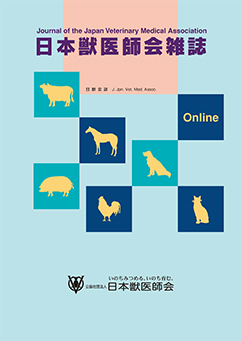
- |<
- <
- 1
- >
- >|
-
Yasuaki INOUE, Hiromi YAGUCHI, Miyuko HIRAMATSU, Yoshihiro WADAArticle type: Short Communication
2022 Volume 75 Issue 4 Pages e51-e55
Published: 2022
Released on J-STAGE: April 15, 2022
JOURNAL FREE ACCESSA Japanese Black calf was born with normal calving but exhibited lethargy and anorexia and died at two days old. At necropsy, no obvious lesions were seen in the umbilical cord, but histologically omphalitis and meningitis from the cerebrum to the medulla oblongata were seen. Bacteriological examination was performed on the heart, lung, liver, spleen, kidney and cerebrum but not the umbilical cord, and extraintestinal pathogenic Escherichia coli (ExPEC) was isolated from all of them. O-genotyping PCR on ExPEC isolates from the cerebrum and lung, revealed Og15 gene positive. Immunohistochemistry showed Escherichia coli O15 antigen consistent with lesions in from the cerebrum to the medulla oblongata and umbilical cord. Based on those, it was diagnosed as purulent meningitis due to ExPEC with omphalitis. If meningitis is suspected in a neonatal calf, the umbilical cord should be examined even without macroscopic abnormalities.
View full abstractDownload PDF (1548K) -
Tetsuya KOMATSU, Yuji TAKAMURA, Nanami INABA, Eri WATANDO, Kennosuke S ...Article type: Short Communication
2022 Volume 75 Issue 4 Pages e56-e61
Published: 2022
Released on J-STAGE: April 15, 2022
JOURNAL FREE ACCESSThe rate of disposal of intestine was found to be increased because of non-tuberculous mycobacteriosis in pigs since March 2018 at a farm in Aichi Prefecture. Therefore, we performed bacteriological and histopathological examinations on environmental samples collected from the farm and the mesenteric lymph nodes of pigs obtained from slaughterhouses in June 2018. We successfully isolated acid-fast bacteria from four different mesenteric lymph node samples with granulomatous lesions. These four isolates had the same genetic characteristics and tested positive with a Mycobacterium avium-specific polymerase chain reaction (PCR) test and negative with the insertion sequences (IS), IS1245 and IS901. The isolates were confirmed to be M. avium subsp. hominissuis (MAH) by hsp65 gene sequences. These isolates had the rpoB and hsp65 gene sequences, which were different from those reported previously. No bacterial strains with similar genetic characteristics were isolated from the environmental samples from the farm. The isolated strains are valuable for studying for their distribution pattern in pigs, and their relationship to the strains found in humans.
View full abstractDownload PDF (1161K)
-
Kyoji YAMADA, Yudai KURODA, Tukasa YAMAMOTO, Hisanari NISHIO, Chizuko ...Article type: Original Article
2022 Volume 75 Issue 4 Pages e62-e68
Published: 2022
Released on J-STAGE: April 15, 2022
JOURNAL FREE ACCESSA 12-year-old indoor cat showed severe respiratory symptoms such as sneezing, nasal discharge and cough. On Day 5 after disease onset, an oral swab was collected and a real-time RT-PCR test was performed to detect severe acute respiratory syndrome coronavirus 2 (SARS-CoV-2), indicating that the sample from the cat was positive for SARS-CoV-2 genes. Since the symptoms worsened on Day 8, a general physical examination, blood tests, chest x-rays and treatment were carried out and oral, nasal and rectal swabs were collected. Mild bronchitis and increased serum amyloid A (SAA) were observed, but it did not lead to pneumonia. In addition, whole-genome analysis revealed that it was the delta variant of SARS-CoV-2. Then the cat recovered, and a significant increase of virus-neutralizing antibody titer was observed in the convalescent serum. In conclusion, this is the first report on a cat with respiratory symptoms caused by SARS-CoV-2 infection in Japan.
View full abstractDownload PDF (936K) -
Hitomi OGAWA, Masahiko OISHI, Takashi OGAWAArticle type: Short Communication
2022 Volume 75 Issue 4 Pages e69-e74
Published: 2022
Released on J-STAGE: April 15, 2022
JOURNAL FREE ACCESSEmergency release of tracheal obstruction by tracheal debulking was clinically applied in two cats with intratracheal tumors presenting severe dyspnea. After thoracic X-ray examination, the airway obstructions with intratracheal tumors were released by intratracheal debulking using a tracheal tubes under general anesthesia. Then, the tracheal tubes were left in place for 10 minutes to compress the bleeding site with its fully inflated cuff. The dyspnea was significantly improved immediately during recovery from anesthesia. The cats received oral steroids to prevent adhesion in thes of intratracheal debulking area after the treatment. The intratracheal tumors wereas histopathologically diagnosed as adenocarcinoma or malignant epithelial tumors in each cat.View full abstractDownload PDF (1826K)
-
Shohei SAKATA, [in Japanese], [in Japanese], [in Japanese], [in Japane ...Article type: Data and Information
2022 Volume 75 Issue 4 Pages e75-e78
Published: 2022
Released on J-STAGE: April 15, 2022
JOURNAL FREE ACCESSDownload PDF (4423K) -
Shohei SAKATA, [in Japanese], [in Japanese], [in Japanese], [in Japane ...Article type: Data and Information
2022 Volume 75 Issue 4 Pages e79-e82
Published: 2022
Released on J-STAGE: April 15, 2022
JOURNAL FREE ACCESSDownload PDF (2664K)
- |<
- <
- 1
- >
- >|